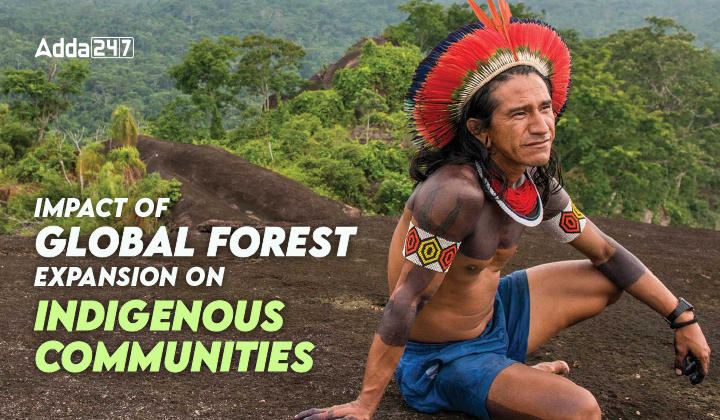Table of Contents
In recent years, the global community has recognized the pressing need to enhance biodiversity and expand forest cover to combat environmental degradation and climate change. This ambition was crystallized in the Kunming-Montreal Global Biodiversity Framework (GBF), which emerged from the 15th Conference of the Parties (COP15) to the UN Convention on Biological Diversity in December 2022.
Kunming-Montreal Global Biodiversity Framework
The Kunming-Montreal Global Biodiversity Framework (GBF) is a landmark agreement adopted in December 2022 at the 15th Conference of the Parties (COP15) to the UN Convention on Biological Diversity. This culmination of a four-year negotiation process is seen as a critical step towards reversing biodiversity loss and achieving a more sustainable future.
The GBF outlines an ambitious plan to achieve the vision of “living in harmony with nature by 2050.” It sets four goals for 2050 and 23 specific targets for 2030. These targets address critical areas such as:
- Protection: A significant focus is on increasing protected areas to encompass at least 30% of the world’s land and oceans by 2030. Currently, only about 16% of these areas are protected.
- Financing: The GBF recognizes the need for increased financial resources to implement its goals. It calls for mobilizing resources from both public and private sectors.
- Capacity Building: The framework acknowledges the importance of building capacity in developing countries to effectively implement biodiversity conservation measures.
- Monitoring and Reporting: A robust system for monitoring progress and reporting on achieved targets is crucial for ensuring accountability.
The GBF represents a commitment from all participating nations to develop and implement national plans to achieve its goals. This includes setting specific targets and strategies tailored to each country’s context.
One specific target highlighted in the article is Target 3, which aims to significantly expand protected areas. Environmentalists and indigenous communities see this target as crucial for conserving biodiversity and ecosystem services.
The Kunming-Montreal Global Biodiversity Framework offers a much-needed roadmap for addressing the biodiversity crisis. Its success will depend on the commitment and collaboration of all stakeholders, including governments, businesses, and civil society.
Potential Challenges and Concerns
While the Kunming-Montreal Global Biodiversity Framework (GBF) presents a significant step towards environmental protection, some potential challenges and concerns have emerged surrounding its implementation. Here’s a breakdown of the key points:
- Indigenous Rights and Displacement: The focus on expanding protected areas raises concerns about the potential displacement of indigenous communities who have traditionally lived in these areas. The symposium highlights examples from Southeast Asia where indigenous peoples have been denied basic rights and even criminalized for living on their ancestral lands within protected zones.
- Corporate Involvement: The inclusion of private sector involvement in conservation efforts raises concerns about potential corporate exploitation of natural resources. Critics argue that this could prioritize profits over true conservation goals and further marginalize indigenous communities. India’s recent amendment to its Forest Act, allowing activities like zoos and ecotourism within protected areas, exemplifies these concerns.
- Historical Context: The symposium sheds light on the historical roots of protected areas, often established for recreational purposes or as hunting grounds for elites. Critics argue that the concept hasn’t evolved much, with ecotourism projects potentially treating indigenous people as exhibits rather than integral parts of these ecosystems.
Kunming-Montreal GBF and its Potential Impact
The Kunming-Montreal Global Biodiversity Framework (GBF) has positive environmental goals, but its implementation in India raises concerns for indigenous communities. Here’s why:
- Overlaps with Tribal Territories: A significant portion of India’s protected areas coincide with lands traditionally inhabited by indigenous peoples. Reaching the GBF’s target of expanding protected areas could threaten their livelihoods and cultural practices.
- Displacement Risks: Examples like the proposed upgrade of the Kumbhalgarh Wildlife Sanctuary and the expansion of the Nauradehi Sanctuary highlight the potential displacement of tribal villages. This raises concerns about their right to their ancestral lands.
- Disputed Land Ownership: The case of the Barak Bhuban Wildlife Sanctuary exemplifies the issue of disputed land ownership. The government claims the land is free of encroachment, while the Khasis possess documents proving their long-standing presence there.
Scheduled Tribes and Other Traditional Forest Dwellers (Recognition of Forest Rights) Act, 2006 (FRA)
This Act is a landmark piece of legislation aimed at rectifying historical injustices faced by indigenous communities and traditional forest dwellers. Here are some key points about the FRA:
- Recognition of Rights: The Act recognizes the rights of forest dwelling Scheduled Tribes (STs) and Other Traditional Forest Dwellers (OTFDs) who have been residing in forests for generations.
- Types of Rights Recognized:
- Individual rights: This includes rights to hold and live on forest land for habitation and self-cultivation.
- Community rights: This includes rights like access to non-timber forest products (NTFPs) and grazing for livestock.
- Process for Claiming Rights: The Act outlines a procedure for claiming forest rights through Gram Sabhas (village councils) and Forest Rights Committees (FRCs).
- Dispute Resolution: The Act provides a mechanism for resolving conflicts related to forest rights claims.
Conclusion:
The GBF and its implementation raise crucial questions about the future of indigenous communities in the face of global forest expansion efforts. While the goals of the GBF are commendable in their focus on biodiversity and ecosystem preservation, the potential impact on tribal peoples cannot be overlooked. As India and other nations strive to meet these global targets, the rights, traditions, and voices of indigenous populations mustn’t be only heard but integrated into the conservation planning and execution process. Achieving a balance between conservation goals and human rights is not only a matter of ethical governance but also essential for the sustainable and just stewardship of the planet’s natural resources.



 TSPSC Group 1 Question Paper 2024, Downl...
TSPSC Group 1 Question Paper 2024, Downl...
 TSPSC Group 1 Answer key 2024 Out, Downl...
TSPSC Group 1 Answer key 2024 Out, Downl...
 UPSC Prelims 2024 Question Paper, Downlo...
UPSC Prelims 2024 Question Paper, Downlo...
